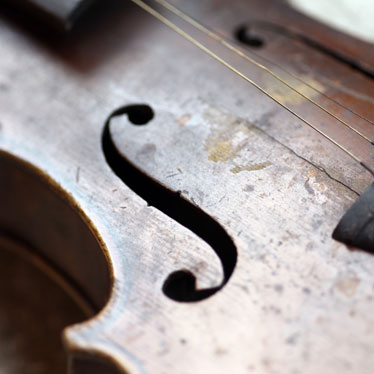When Is It Time To Step-Up To A New Violin?

Students who begin violin training typically start out on an instrument that is classified as a “beginner” model. Depending on personal circumstances, some parents and students choose to rent an instrument at first, just to ensure that the violin is the right fit, and then eventually purchase a well-set up beginner instrument for continued training. Eventually though, players will outgrow their first violin, either in size or aptitude.
Once the student progresses to a certain ability level, changing to a higher grade violin will make an incredible difference in the sound the player is able to produce. Warmer, richer tones that issue from a well-crafted, artisan instrument improves performance capacity, and provides the advanced apparatus required to shine out at auditions and other venues.
However, upgrading to a new violin is a pretty big commitment for most people. The cost of a new instrument can be quite an investment, so you need to be sure that you’re ready for an intermediate violin before you buy one. If you’ve been taking music lessons for a while and are unsure about whether or not an advanced quality or larger size instrument will enhance your skill, these guidelines can help you recognize when you’re ready to make the upgrade and offer some tips about buying a violin.
- Feeling Stifled. Many players, when they are ready for step up violins, will feel frustrated with their current instrument. Maybe you have a very hard time playing notes higher in the register, or it is very difficult to perform certain bowing techniques. This is a case where mature judgement is required. If replacing the strings on your beginner instrument will make the necessary improvements, you want to try that option first. However, if you know your violin is set-up excellently, but you’re still having issues with the sound you think you could create, looking over some good violin brands for a better quality instrument may be the way to go.
- Years of Training. This is another good indicator of when you might be ready to consider step up violins. If your student has been training for at least three years, it may be time for an intermediate violin. But, before buying a violin, you should understand the characteristics that differentiate advanced models.
- Sizing. When students start out on fractional size instruments, as the child grows, you'll need to monitor certain areas to ensure that the violin isn't too small. While it's much more dangerous to play an instrument that is too large, a too small violin presents it's own difficulties. Have the student hold the violin normally, but grasp the scroll from underneath with their left hand. If their elbow is bent 90 degrees or less, it's time to upgrade to a larger size instrument.
These issues generally indicate that you have progressed beyond the level of your current violin. In order to grow as a musician, you need the right tools.
Tips for Buying a Violin
When you are ready for an intermediate violin, the main thing to remember is to take you time. There’s no rush. You still have your beginner model instrument to play, and the new instrument you buy will be your primary violin for quite a few years, so you’ll want to choose wisely.
- Talk to your instructor. Getting professional advice is always a great idea, and your instructor is in a key position to understand if you are ready to upgrade or up-size your instrument. Ask for your teacher’s opinion about good violin brands and if they think you’re ready for a change.
- Speak with a few local dealers and do some research. Finding step up violins at your local instrument shop is a great place to start. Luthiers and violin enthusiasts love to share their knowledge and are usually happy to offer expert advice on good violin brands to consider.
- Play lots of instruments. This is the key for finding an intermediate violin that you will love to play. Devote a few afternoons to sitting in shops trying out instruments. It’s also a good idea to have someone with you to listen from different perspectives, and to take a little notebook. Write down the model and what you loved about it so that you can refer to your notes later.
- Ask about trade-in options. This won’t always be possible, but some instrument dealers offer trade-in discounts for your beginner violin.
Choosing the right violin for your growth will take some time, but be patient. The upgraded instrument you select will be your instrument for a while, so make sure that you use all of your resources when making your choice.


